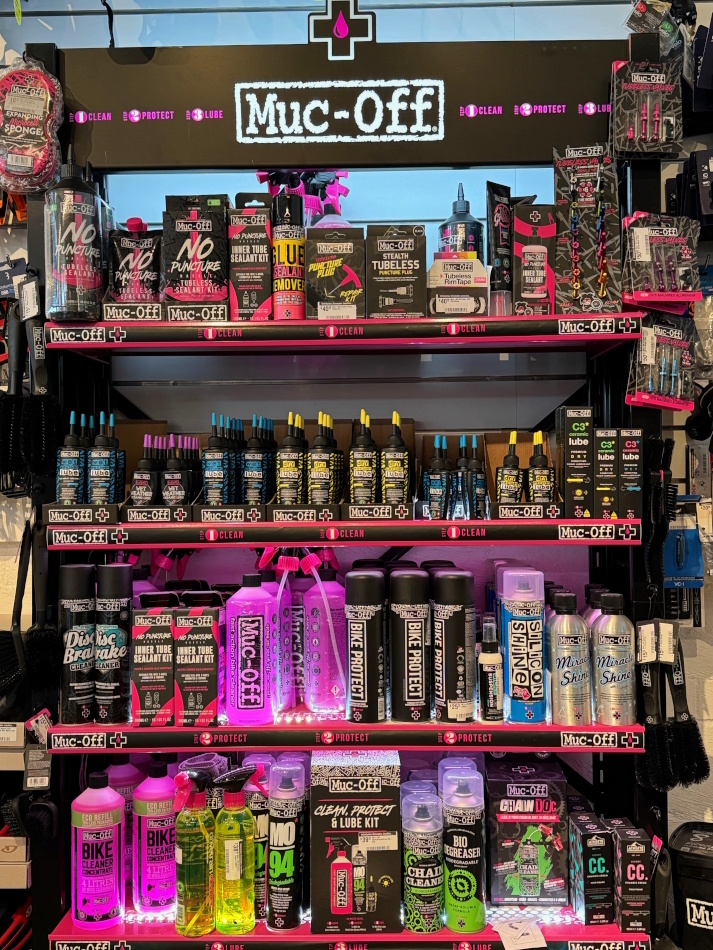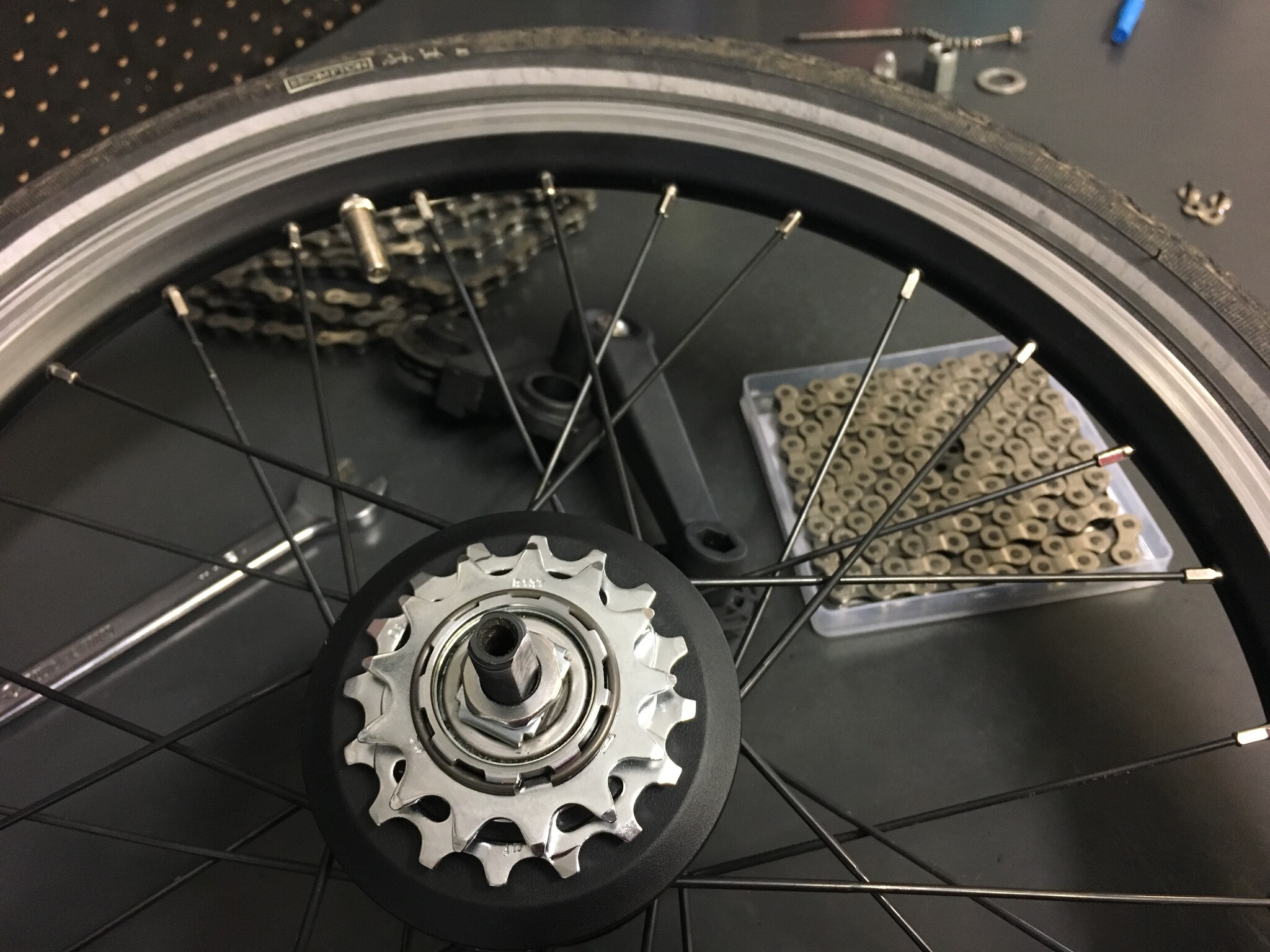FAQ’s: Bike Servicing & Maintenance
- Posted on
- Posted in Maintenance, Servicing
- 0

You’ve likely heard the bike shop mantra ‘regular servicing is best’ – but why is that?
Here we answer questions frequently asked by customers about general maintenance and servicing with the aim to keep you riding safely and smoothly for longer.
Regular servicing by our workshop team is about maintaining your bike in optimal condition. There’s plenty you can – and should! – do at home, such as checking your tyre pressure every fortnight, and cleaning and lubing your drive train when it’s dirty or dry. These small tasks are equivalent to brushing your teeth – but for your bike. The trip to the ‘dentist’ for a proper check-up is booking in for a service, at least once a year – but we’ll cover that in more detail below.
Tyres – Pressure and Tread
What pressure do I need?
Check the sidewall of your tyre to find the pressure range suggested by the tyre’s manufacturer. The information may be moulded into the tyre or printed on, and sometimes it can be tricky to find - but it will be there somewhere. As a rule of thumb, high volume tyres (eg mountain bikes, fat bikes) require lower pressure compared to low volume tyres (road bikes, Bromptons).

How often do I need to check my tyres?
Checking the pressure every week to fortnight is a good habit to get into. If you don’t ride regularly, we recommend always checking your tyre pressure before setting out on your ride. All pneumatic tyres will lose pressure over time, ridden or not.
The smaller your tyre (width and/or diameter) the faster it will lose pressure compared to a larger tyre; this is because a small loss of air results in a greater volumetric change in a smaller tyre, and therefore pressure change.
How to use a pump?
The crew at GCN have prepared a comprehensive guide covering this topic, but if you have any further questions, or something's giving you trouble, come in and talk to us!
When should I replace my tyre?
Usually when the rolling surface is worn so that you cannot see the tread pattern clearly anymore; the green/blue foam protection layer in Schwalbe tyres is NOT tread. On slick tyres (smooth tread) we check to see how squared/flattened the rolling surface has become.
Other causes to replace a tyre include:
- Sidewall damage; can result from riding past something sharp (eg wire, glass) or from riding too often with under-inflated tyres.
- Bead damage; can result from poor technique in fitting or removing tyre, over inflation, aging tyres
- Repeated punctures from road detritus.

Can I inflate my tyres at a service station?
We do not recommend using service station air compressors for bicycles, even if you have a compatible (Schrader) valve. The air compressors here are designed to inflate motor vehicle tyres where a lot of air is required in as short a time as possible. Therefore the main issues are two-fold:
- Air delivered too quickly can blow the tyre bead off the rim, damaging tube (if you use one), tyre and possibly even the wheel rim.
- Service stations rarely deliver pressure to a rideable pressure for most bikes. Remember; low volume tyres (eg bicycles) require higher pressure tyres compared to high volume tyres (eg cars).
Chain (and Drive Train)
How often do I need to lube my chain?
For most commuters the answer is ‘When it’s dirty’ or ‘When it’s dry/squeaky’ and almost certainly ‘More often than you do now’. The more dirty, dry, greasy and/or gunky your drive train (i.e. all the parts involved in turning your rear wheel – chain, sprockets, derailleur), the less efficient your ride and the faster your parts are wearing out.
How do I clean my chain and drive train?
At minimum you will need chain lube and a supply of cotton rags or cleaning cloths. Depending on the type of bike you have and how often you maintain your bike, you will also need products such as disc brake cleaner, general degreaser, cleaning brushes.
We stock the Muc-Off range of bike care products. Biodegradable, affordable, and used by everyone from average commuters to professional riders and racers.
The basic steps to clean a chain are as follows:
- Clean grease and dirt from your drive train parts. Depending how dirty your parts are to start with, you may need to use degreaser to assist in this process.
- Ensure your drive train is clean and dry before applying the lube. Aim for one drop per chain link.
- Work the lube through the chain (back pedal a few times). Wipe off any excess lube.

We have leaflets available with our Muc-Off products demonstrating how to use them.
Which lube should I use?
We have the following Muc-Off chain lubricants to choose from:
- Wet – for use in damp to wet riding conditions
- Dry – for use in dry and dusty riding conditions
- All Weather – for use in dry or wet conditions
- Ceramic Dry/Wet – as above, but the ceramic formula offers better performance and efficiency from your drive train
- E-Bike Wet Weather Ceramic - for use in damp to wet riding conditions on an E-bike (higher torque than non electric)
I clean my chain - why am I paying to replace it so often?
A frequent and thorough cleaning regime will extend the life of your drive train, and make your ride more efficient, but will not prevent wear due to use. In other words, the more kilometres you ride, the sooner you will need to replace your wearable parts.
You don’t have to clean your bike and lube your drive train – and plenty of people don’t. BUT the trade off is higher costs and more frequent servicing plus a dirtier bike that’s a bit hardier (and noisier) to ride.
Booking a service
How often do I need to get my bike serviced?
As stated at the top of this post, servicing is about maintaining your bike in optimal condition. This means replacing worn parts before they break as well as adjusting parts (not being replaced) for a smooth, efficient and safe ride.
If you use your bike on a semi regular basis, or if you have an e-bike (more on these below), servicing should be at least once a year. The further you ride, the more frequent your servicing should be. For example, a commuter doing 20km per day / 100km per week should be booking 2 services a year. If the same bike is also used for weekend escapes, that frequency might need to be brought forward to every 5 months.
Load (rider plus luggage) also has a bearing on your servicing frequency. A bike ridden by a lightweight (50-60kg) fair weather rider will not have the same wear as the same model of bike that’s ridden by a heavy person with double panniers (100-110kg) in all weather conditions.
Older bikes typically have higher servicing costs compared to new bikes as more components have had time to wear out and need replacing.
If you’re not certain how long it’s been since your last service… it might be time to book one in. Catching something in advance is always more cost effective than replacing broken parts (and people). Along with a service we can advise when to book in next and/or what indicators to look out for to signal when to book your next service.

How long do parts last?
The answer to this usually depends on use and quality of your bike's components. As mentioned above, regular cleaning and maintenance helps extend the life of parts but this cannot eliminate the effect of wear from usage. Higher end components cost more, but will last longer as they’re made from better quality materials and to finer tolerances.
An easy analogy to use here are sneakers. A cheap pair of shoes may look good new, but they’ll have no support, the soles will wear out before you’ve walked/jogged 100km and your toes are poking holes in the uppers. A reasonable quality pair sneakers may have some foot support, will last a few hundred kilometres and the uppers should also be reasonably good. A top quality pair of sneakers will take a beating over a longer distance whilst still providing support and protection to your feet.
In summary, if you use your bike regularly, if you rely on it as your main means of transport, you should be investing in both quality components and regular servicing. We can provide advice specific to your bike and needs at your next service.
E-Bikes
Are e-bikes more expensive to service than regular/non-e-bikes?
The “per service” cost is fairly comparative, but servicing frequency for e-bikes is typically higher compared to regular (non-electric) bikes. Tyres and brake pads typically wear out faster because:
- The bikes are heavier and have more mass to stop
- It’s easier to reach an average faster speed (20-25km/hr) compared to what you’d ride at unassisted. If you don’t adjust your braking time/distance accordingly, you can really wear our your brake pads (and rotors) in no time.
- E-bike riders have been found to ride further and more often compared to what they would on a non-assisted bike. The further you ride, the faster your components wear out, the more frequent your servicing should be.

Brompton Folding Bikes
Are Bromptons more expensive to service than a regular bike?
Typically servicing costs are no different to a regular bike, but several factors will increase these:
- Bromptons typically last their owners quite a number of years. Depending on load and frequency of use, servicing costs trend upward from ~5-8yrs and onwards as longer-lasting parts start wearing out, eg braking surfaces/rims, seat posts, headsets, etc.
- Hinges need servicing. Again, depending on load and frequency of use, all hinges that permit the bike to fold, plus the seat post sleeve, require specialist servicing.

To book your bike's next service, call us on 03 9381 0088 or pop in to talk to our friendly staff!


Comments
Be the first to comment...